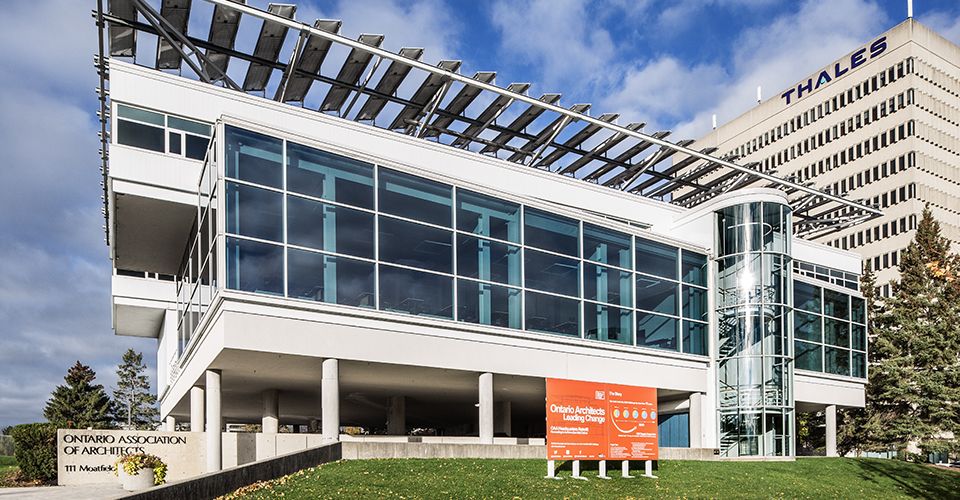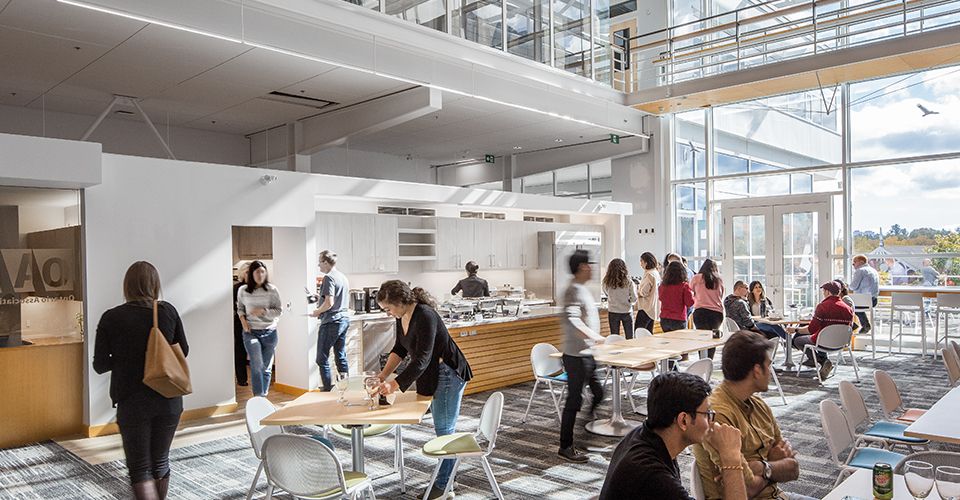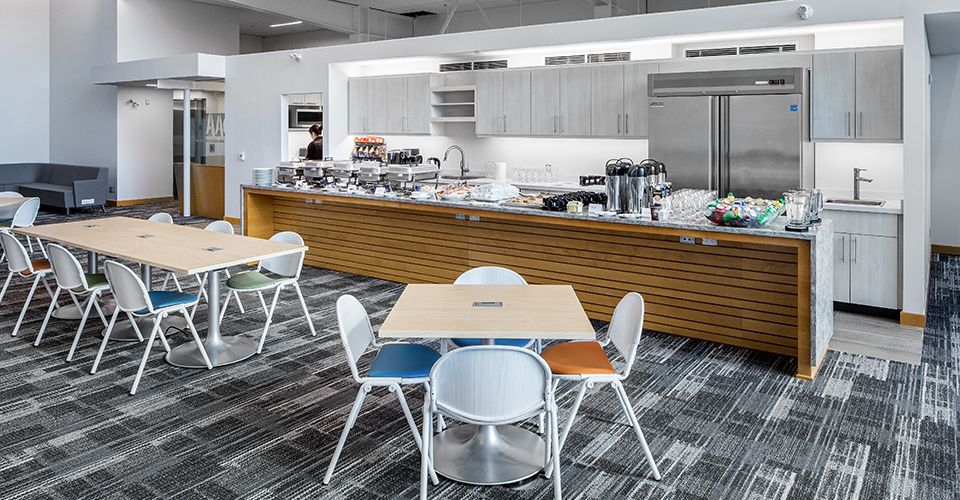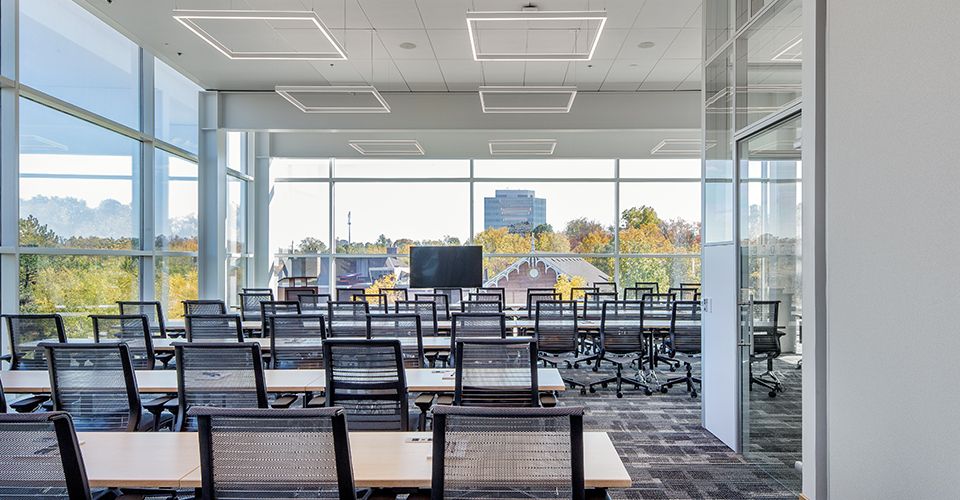Given its role as a regulator, promoter, and resource for Canadian architects in Ontario, it’s hardly surprising that the Ontario Association of Architects would want its Don Mills headquarters building in Toronto to meet the loftiest of sustainable standards. Originally designed by Toronto architect Ruth Cawker, who won a province-wide competition to create the building in 1988, the headquarters facility was built to meet Canada’s R-2000 Standard, a more elevated energy and environmental benchmark than the norm at the time. But since the OAA occupied the building and steadily grew over the past 25 years much has changed, and its energy use was much higher than the average for new low-rise office structures, partly due the 22,000-square-foot structure’s outdated mechanical system. So, when the OAA Council reviewed its options to bring the facility up to date, it opted to redesign the existing structure to not only meet the carbon neutral objectives set forth by the non-profit organization Architecture 2030 in its 2030 Challenge, but also to exceed them.

When the OAA decided to retrofit their headquarters, both operational and embodied carbon guided their decisions and selections. Image ©2019 Steven Evans c/o ImagingTree.com
“Our primary role as an organization is to promote architecture for Ontario and keep architects in line with global parameters,” says architect Sheena Sharp, chair of the OAA’s building committee. “Because of our mandate, the 2030 Challenge is applicable to our objectives to educate architects and the public on the value of architecture and to serve as a regulator for the profession.” As such, the OAA’s committee for sustainability was determined to demonstrate a sense of leadership with respect to energy consumption, and they recommended retrofitting the building to make the most of its inherent embodied carbon rather than building a new one. “At the start, embodied carbon wasn’t on our radar,” says Sharp. “But we know we can’t afford to throw away buildings and start new. That’s the wrong message. Preserving and retrofitting the building was also in line with our cultural and financial goals. All were driving us in the same direction.” So, once the OAA decided to retrofit their headquarters, both operating and embedded energy guided their decisions to ensure the building’s life cycle performance would be as environmentally sustainable as possible.
First issued in 2006, the 2030 Challenge serves as a call to the global architecture and building communities to meet a series of performance standards in stages to address the threats of climate change. Supported by the American Institute of Architects since 2010, its initial target for designers of new buildings and major renovations was to meet a fossil fuel, GHG-emitting, energy consumption performance standard of 70 percent of the regional average for any comparable building type at the time. In 2020, that target increased to 80 percent, by 2025 it will increase to 90 percent, and by 2030 the aim for new and substantially renovated buildings is to be carbon neutral, meaning they’ll require no fossil fuel energy at all to operate. And when the OAA opened its doors again in June 2019 after its major retrofit and interior renovation, the updated structure not only met the Challenge’s 2030 carbon neutral goals ten years ahead of schedule, but also stood as a pioneering example of sustainable design. “We wanted to make the existing structure a great building, but we also wanted it to contribute knowledge to key societal issues and educate our members,” says Sharp.
Retrofitting the building to achieve carbon neutral goals
“There were two big pieces to the renovation: A deep energy retrofit and an interior refresh,” says Kristi Doyle, executive director of the OAA, who credits the committee and project architect David Fujiwara, who advised on the structural and mechanical retrofit, for transforming the building into a model of sustainability. Among the steps Fujiwara took to meet the carbon neutral goals was to improve the envelope and replace its mechanical system and windows. “We reviewed characteristics of the building that could work to our advantage or were challenges,” says Fujiwara. “The orientation of the building, which faces due south with no shadow from other buildings or trees, was ideal and the steel roof canopy served as a perfect place for the solar photovoltaic panels that can produce about 100 MWh of energy per year. But the building envelope needed improved insulation all around and the office strip windows needed to be upgraded from aluminum frame double-glazing to fiberglass frame triple glazing with electrochromic shading, low-E film, and argon gas fill.” The architect also found space on the property’s lot to drill fifteen 600-foot-deep looped wells into solid rock to create a geothermal system for winter heating and summer cooling.
Interior strategies and materials
Although an interior office renovation was not part of the original plan, as the design development progressed, it became clear to all that bringing the interior office layout up to date would not only improve the function, flow, and transparency of OAA’s work environment, but also complement the organization’s environmental objectives. Working with designers from Interior Architects to help with functional planning on the layout, which had consisted mostly of enclosed 9’x15’ private offices, OAA opted to start fresh and convert the over-scale offices on the top two floors of the 3-story building into mostly open-plan workspaces.

Image ©2019 Steven Evans c/o ImagingTree.com
In the redesigned space, the majority of OAA’s staff members are clustered into functional groupings and work collaboratively at generous, paired L-shape workstations with access to the natural light coming through the perimeter windows. “The change to a primarily open-plan office also happened to dovetail nicely with the changes to the HVAC and lighting systems,” notes Fujiwara. While the updated interiors now include just three private offices, numerous new enclosed meeting rooms of various sizes and outfitted with state-of-the-art video-conferencing equipment offer semi-private collaboration spaces on the third floor and overlook the double-height atrium and café space in the center of the building on the first floor.
“With the interiors changes, we were able to significantly increase the number of people who could occupy the space for member services,” says Sharp. “While we have a staff of 30, we serve 4,500 members who use every kind of computer and 38 committees of architects who regularly meet at the headquarters. We’re also a regulator, so if there are public complaints or violations, we run disciplinary and judicial processes that require lawyers and breakout hearings. Plus, we handle the licensing process and provide education for intern architects and offer online exams, which means everyone from interns to licensed architects regularly visit the building,” says Sharp. “So, by reconfiguring the space to add five meeting rooms and creating cafe space and lounge areas where you can work independently on laptops, we essentially doubled the amount of people we can serve on the same amount of energy, even though there’s no metric to measure that.”
Materials matter
From a materials perspective, the carpet tiles from Interface that cover the floors throughout also contribute to the building’s carbon neutral equation even though metrics for materials were not included in OAA’s calculation to meet the 2030 Challenge. Knowing of its longstanding history as a leader in the manufacture of eco-friendly flooring, Fujiwara intuitively gravitated to Interface flooring for the offices. “I was aware that Interface had a commitment to sustainability and was drawn to the company’s products when I found out they used recycled content in the carpet yarn and post-consumer content in the tile backing,” says Fujiwara, who worked with Eve Marshall Interior Design and the OAA’s building committee to choose the interiors finishes. After reviewing several options, the team selected two complementary colorways of SummerHouse Shades™ carpet tiles from Interface’s World Woven™ Collection to bring a sense of warmth and cohesiveness throughout the office interiors.

SummerHouse Shades carpet tiles from Interface. Image ©2019 Steven Evans c/o ImagingTree.com
Aside from its sustainable attributes, several other qualities drove the team’s choice to use the Interface carpet tile, including its high-quality and appealing design, durability, ease of maintenance, and affordability. “I was looking for a pattern that would not be overly pre-determined, non-repetitive, had variety and texture, and was somewhat rectilinear,” says Fujiwara. “The Summerhouse Shades pattern had the qualities I was looking for.” In addition to the aesthetic features of the carpet, the client especially appreciated its pragmatic benefits. “The carpet gives a sense of energy to the space,” Sharp explains. “It’s also good to have tile because if someone spills coffee during the work day, you can easily change the carpet out. Not only do these carpet tiles adhere properly, they also come off easily. Cost was also a benefit as the tiles were reasonably priced. And the carpet, like ceiling tiles, absorbs sound in the open office space.” Interface’s reliability and longstanding history as a company also played a role in carpet selection process. “Interface has a good reputation and has been in business for a long time. So, we knew that if we needed to replace more tiles, they’d be around for a while,” adds Sharp.
Taking the measure of product to meet the 2030 Challenge
While metrics on the carpet tile’s sustainable qualities weren’t factored into the decision-making for the OAA project, the Summerhouse Shades tiles, like all Interface products, are included in the company’s Carbon Neutral Floors™ program, which not only assures through third party verification the carbon neutrality of all of its products across their full product life cycle, but also calculates the floor’s carbon impact so clients can see its contribution to reducing global warming.
Indeed, the history of Interface’s approach to producing eco-friendly products, as well as its leadership role in the evolution of the guidance for products in the 2030 Challenge, have blazed a trail for other product manufacturers and the industry to follow. “There’s no for-profit entity in the world that is more aligned with Architecture 2030 than Interface,” says Mikhail Davis, director of technical sustainability for Interface. Recognizing that its 2030 Challenge was focused only on operational emissions when it launched in 2006, Architecture 2030 later turned its attention toward the embodied carbon in products as part of the equation in aiming toward carbon neutrality.
“They realized that the whole idea of embodied carbon was perhaps just as big as the operational challenge, and so, back in 2011, they developed the 2030 Challenge for Products with the idea that manufacturers would commit to a 50% reduction in carbon footprint of their products by 2030, based on data from Environmental Product Declarations. Interface was the first company to sign up,” says Davis. “We were the first company of any kind in North America to put out an Environmental Product Declaration back in 2009, and our products were already on track to meet the 2030 goal. The trick was that most companies had not even put out an EPD in 2011 and, as a result, couldn’t commit. So, the effort was shelved because of a lack of adoption and clear benchmarks.”

Image ©2019 Steven Evans c/o ImagingTree.com
Since then, however, Interface has worked with Architecture 2030 to promote an attribute-based tool, the Carbon Smart Materials Palette, to enable designers to reduce embodied carbon even where EPD data is unavailable. “Our challenge now is to get the market to care about embodied carbon and keep score on it, and we’re working with Architecture 2030 and others to make that happen,” says Davis. “So, we love that projects like the OAA’s are engaged in the process.” The Carbon Smart Materials Palette (materialspalette.org), enables users to look for or avoid specific attributes in each product category that affect embodied carbon emissions, a “spec this, not that” approach for designers who don’t have time to do a quantitative analysis using EPDs.
“As a rule of thumb, if a project is a new build with big structural work involving concrete and steel, flooring is going to be less than 5 percent of the project’s embodied carbon, but if you’re doing a renovation or tenant improvement, flooring can account for 20 percent,” says Davis. “And then it’s a really important choice.” The Carpet Swatch in the Materials Palette explains that the number one driver of embodied carbon emission in carpet is the use of virgin nylon yarn. “Nothing else can cut carbon as much as using carpet made with recycled content yarn,” says Davis. “If you were to switch to 100 percent recycled content nylon, which we do for over half of our product line, it’ll cut your footprint in half immediately. Other recycled content doesn’t matter as much.”
In the OAA project, the Summerhouse Shades carpet tiles with GlasBac™ backing have 30 percent lower embodied carbon emissions in their cradle-to-gate carbon footprint per square yard than average North American commercial carpet tile as calculated by the Embodied Carbon Calculator for Construction (EC3). EC3 is a free design tool originally created by the University of Washington’s Carbon Leadership Forum that analyzes data on building products published in EPDs. “Every 2,039.18 square yards of this product purchased compared to the average alternative is equivalent to eliminating the CO2 emissions from driving an average car more than 28,000 kilometers,” says Davis.
The Summerhouse Shades product is made from 100 percent recycled content nylon, including post-consumer content from fishing nets collected in British Columbia’s Steveston Harbour and by Interface’s village-scale Net-Works™ partnership, which supports subsistence fishing communities in the Philippines and Cameroon. It also has a GreenCircle Certified Environmental Facts label that shows verified recyclability at end of life along with more than 30 other verified environmental claims about its impact.
Poised for a Post-Covid World
Since the OAA had the opportunity to occupy their retrofitted building for just a few months before the pandemic forced the staff to work from home starting in March, they didn’t have much time to enjoy the benefits of the new space. But they know it’s prepared to serve them well in a post-Covid work world.
“The original forced air HVAC system was removed and replaced with a ventilation system delivering 100 percent fresh air at a low velocity,” says Fujiwara. “With the low-velocity system, virus droplets are less likely to be blown around and will tend to settle in the vicinity of where they originate.” Furthermore, the new glass-enclosed private meeting rooms were made for varying sizes of groups and these rooms may be used to accommodate groups of different sizes in line with social distancing rules. They were also fitted out with video-conferencing equipment that allows for remote collaboration and meetings. “Half of the members we serve live in Toronto, but others live in the surrounding area from Thunder Bay, Ottawa, and Windsor to Niagara and the west shore of Lake Superior,” says Sharp. “The farthest area served is roughly 1,000 miles from Toronto. Since the meeting rooms have a large screen, we can do a combination of local and distance meetings.”

Image ©2019 Steven Evans c/o ImagingTree.com
Sharp also believes the carpet will ease any adjustments that may be required to address social distancing requirements when they move back in this fall. “The uniform carpet throughout will be helpful in terms of flexibility,” says Sharp. “It will enable us to reconfigure without a hassle and won’t need to change if we need to move work stations farther apart.” Doyle believes the carpet will also contribute to enhanced productivity. “If people don’t like the carpet, it affects how they think, and one of things we’ve heard from numerous architects is ‘Oh, I love the carpet,’” she says. “It rose to the top from an aesthetic perspective.”
And while carbon reduction relative to energy saved due to remote working or the use of interior products was not part of the OAA’s thinking at the start of the project, Sharp suggests that the organization might consider looking at these factors in a post-occupancy analysis. “We didn’t analyze embodied carbon of materials during the design process, but I could recommend that we do a study to provide that background. And we could do a metric on energy saved with less travel,” she says.
Meanwhile, other companies interested in reducing their embodied carbon footprints in new buildings or retrofits in the future now have more options from Interface to choose from. Not long after the OAA project was completed, Interface launched the first carpet tiles in the world with negative embodied carbon. “Our mission as an organization is to show the business community how to reverse global warming,” says Davis. And in keeping with the vision of its founder, Ray Anderson, who was committed to making Interface the world’s first environmentally sustainable and restorative company, Interface’s Climate Take Back plan establishes a template that leads the way toward reversing global warming through radical decarbonization and encourages others to do the same.